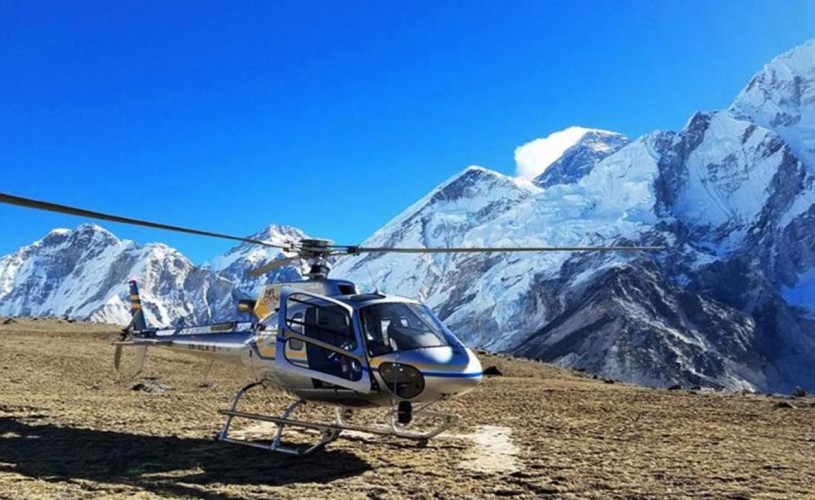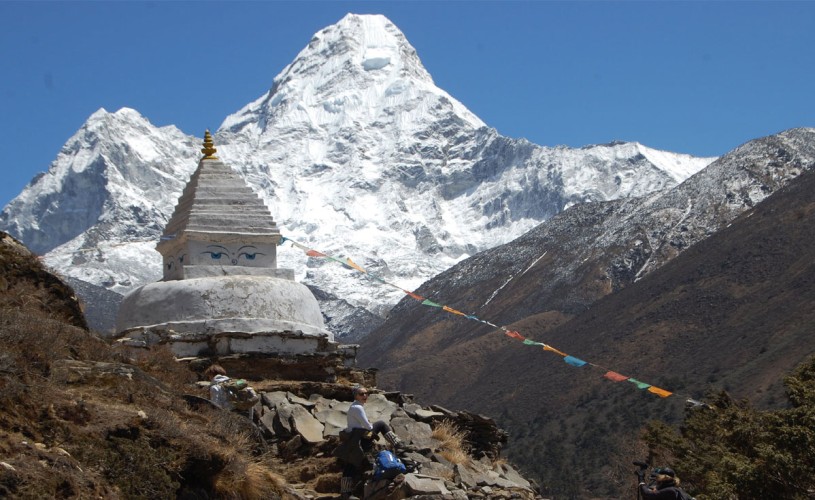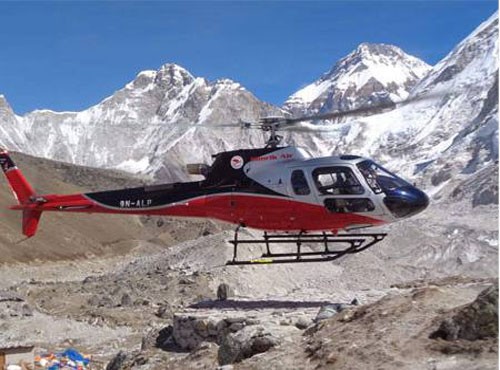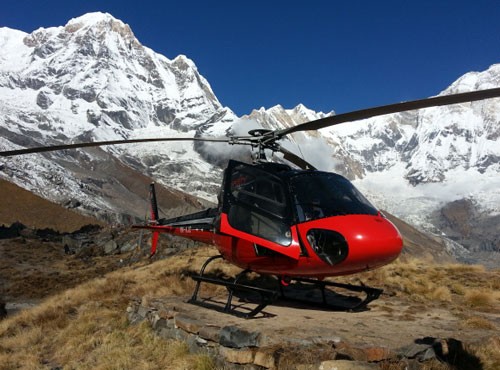Everest Base Camp Trek with Helicopter Return Highlights.
- Lukla is a scenic 40-minute mountain flight.
- Namche Bazaar is a city blessed with natural beauty.
- Discover the amazing culture of Sherpas by visiting their museum.
- Amazing views of Mt. Everest, Lhotse, and Nuptse are just a few.
- Trek on the Khumbu Glacier and witness the Khumbu Icefall
- Within 08 days, you can reach Everest Base Camp and enjoy the 360° views of Everest.
- Sunrise view of Mt. Everest from Kalapathar, the best viewpoint in Nepal.
- Helicopter scenic flight from Kalapathar/Gorkashep, Nepal, to Kathmandu.
Everest Base Camp & Helicopter Return Cost for 2025/2026.
The Everest Base Camp Trek with Helicopter Return from Gorakshep to Kathmandu (8 days) is specially designed for those with limited time. EBCTrek with Helicopter Return allows adventurers to experience the beauty of trekking in the Himalayas and enjoy an Everest Base Camp Helicopter Tour, making it an ideal choice for those seeking a shorter but still thrilling journey.
A journey to Everest Base Camp in Sherpa Land is an amazing adventure. This classic trek offers breathtaking views of the Everest Himalayan ranges, stunning sunrises over Everest, majestic landscapes, ancient historical monasteries, and a glimpse into the unique Sherpa culture. It's an opportunity to sign up now and explore the Nepal Himalayas, a trip that could be truly life-changing
Everest Base Camp Trek with Helicopter The return begins with a scenic 35-minute flight to Lukla, the gateway to the Everest Region treks. From Lukla, the trail winds through Sherpa settlements, Sagarmatha National Park, and suspension bridges, leading to Sherpa villages like Namche Bazaar, Tengboche, Pangbuche, and Labuche. The ultimate destination is Everest Base Camp, a moment worthy of celebration. The adventure continues as trekkers climb to Kalapatthar, the highest point of the trek, to witness 360-degree panoramic views of the world's highest mountains, including Mt. Everest, Lhotse, Nuptse, Pumori, Ama Dablam, Khumbuste,Thamserku, andIsland Peak. The descent follows, leading to Gorakshep, from where a scenic chartered helicopter flight takes trekkers back to Kathmandu.
Trekking to Everest Base Camp with a helicopter return itinerary is carefully crafted to account for potential Lukla flight cancellations and risks. This ensures a smooth and secure journey, allowing participants to enjoy the mesmerizing views of the Himalayas and scenic landscapes during the return helicopter flight. Joining this adventure means having the trip organized according to your time and requirements, with a strong focus on safety and security throughout the journey. The day-to-day itinerary can be checked for details, and customization is welcomed to tailor the trip to individual preferences.
Adventurer Club Trek ensures a fantastic experience without tiring you out. The Everest Base Camp Trek With Helicopter Return is an ideal Himalayan adventure. Explore the mountains fully and return to Kathmandu via Lukla effortlessly by helicopter, saving yourself from a weary trek back. It's a great package for those who want a short but immersive Himalayan experience.
It's important to note that starting from April 2024, the Civil Aviation Authority of Nepal announced the suspension of flights from Kathmandu to Lukla during peak trekking seasons, specifically from April 1 through May 30 and October 1 through November 30 each year.
Other Choices to Consider
We offer different trekking packages in the Everest region. If you love trekking and want to experience it in the Everest area, you might be interested. One option is the EBC Heli Trek Return, 9 days. There's also a 14-day Everest Base Camp Trek and a 12-day package with a helicopter return from Gorakshep to Lukla, then a flight to Kathmandu. If you prefer a shorter trek of 7 days, there's the Everest Base Camp Helicopter Trek. Every journey allows you to savor the rich culture and breathtaking landscapes of the mountain region.
Please contact us before booking, as helicopter availability can be limited due to weather conditions or high demand during peak tourist seasons. Many helicopters are often engaged in high-altitude rescue operations, providing essential medical assistance. Additionally, the Everest Base Camp Helicopter Tour is more popular than the Gokyo Lake Heli Tour, which can also affect availability. To ensure a smooth and memorable experience, we recommend confirming availability in advance.
How difficult is the Everest Base Camp Trek with helicopter return?
The trek to Everest Base Camp, complemented by a return journey via helicopter, offers a stunning expedition to the foot of the world's highest mountain. Participants embark on a one-way trek to ascend to the base camp, where the need for descent on foot is eliminated. Instead, trekkers have the option to soar back in a helicopter, with the choice of returning to either Lukla or Kathmandu based on personal preferences. The Everest Base Camp Trek typically falls within the demanding to moderate category, requiring no specialized mountaineering skills. Spanning a considerable distance and reaching an elevation of 5,364 m (17,599 ft), this trek demands 6-7 days to navigate through diverse terrains on the ascent to the base camp.
When is the best time to trek Everest Base Camp with a helicopter return?
In Nepal, there are four seasons: spring, winter, monsoon/summer, and autumn. Spring and autumn are the most popular times for the Everest Heli Trek. Spring is a season of new beginnings when hills and forests regain their greenery. Autumnis also a season of peak beauty in nature.
The weather is calm, and temperatures are mild in the spring and autumn. The climatic conditions during these seasons are neither too hot nor too cold. This is the perfect time to go on an Everest Base Camp Heli Trek.
Beautiful vegetation, including colorful flowers and rare plants, surrounds the routes. The mesmerizing mountain views accompany you on your journey. Aerial views are also spectacular under clear skies and sunny days. The spring and autumn seasons are less likely to be affected by cancellations and delays due to the low probability of snow or rain.
Food for the Trek to EBC and Helicopter Return
We will take care of your food during your trek. You'll enjoy a delicious breakfast each morning in Kathmandu. Our guests are treated to special welcome and goodbye dinners. The trek is a simple yet satisfying experience. The Teahouse will serve you a delicious dinner and a filling breakfast to start your day. You'll be able to enjoy a tasty lunch as you trek from one destination to another during the day. The teahouses have a wide range of culinary options, including Nepalese, Tibetan, and continental cuisine. There are many options to suit your tastes and keep you energized during your trek.
Accommodation on EBC Trek with Helicopter Return.
You will be staying in a standard three-star hotel in Kathmandu and a teahouse or guesthouse on the trek. All accommodation is on a shared basis. On request, a single supplement is available at an additional cost. Adventure Club Trek can arrange for rooms that have attached bathrooms, but some teahouses only offer shared facilities. Single rooms are available in Kathmandu, the trekking areas, and at lower altitudes. However, they may be difficult to find at higher altitudes.
Drinking water on the trek to EBC and helicopter return.
Adventure Club will provide all meals for the trek, but you are responsible for providing water. It is best to use a SteriPen or chlorine/iodine tablets to disinfect the water. You can get free, good-quality water at the tea houses and along the trail, but you'll need to treat it. Use the tablets only if they have dissolved completely (30 minutes). Mineral water is available along most trails. Mineral water costs USD 1 per liter at tea houses located in lower elevations. However, higher elevations may cost as much as $4, so the cost can add up.







